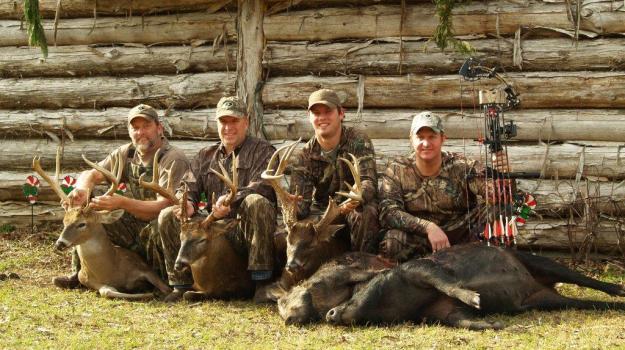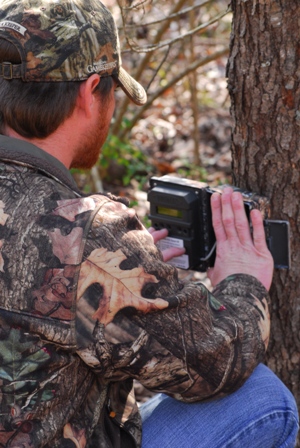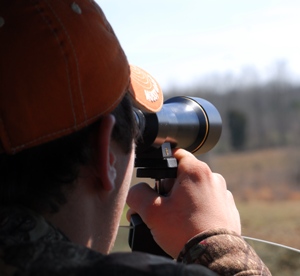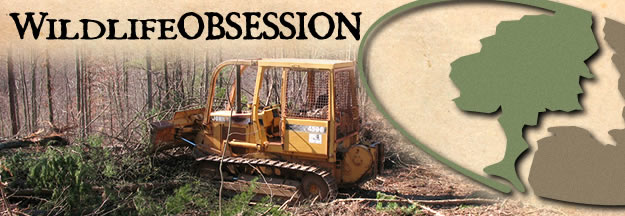
Controlled Pressure Equals Great Results
By Neill Haas
Being a GameKeeper is a way of life for all of us at Mossy Oak and we work extremely hard to bring the best out of the land we manage. I have had the opportunity to grow up around some great hunting spots. One thing I have noticed is the best spots are all carefully managed for their hunting pressure. Managing land is much more fun than managing hunting pressure, but if you do it right one won’t take away from the other and both will lead to regular success.
Having several access routes, multiple stand sites for different wind directions and even several properties to hunt can really help a hunter manage pressure. Our Alabama farm is a great example of - little pressure equals great results.
 We had hunted the farm lightly up until January. We monitored deer activity from a distance and have learned to wait and be patient. If you can allow your herd to feed unpressured, when the rut rolls around food plots can be the hottest spot on the property. Bucks follow does right out into the plot during daylight and bucks will travel the “circuit” to scent-check plots all day long. When designing our plots we worked hard to make sure the whole plot couldn’t be seen from one location, forcing an unpressured cruising buck to expose himself.
We had hunted the farm lightly up until January. We monitored deer activity from a distance and have learned to wait and be patient. If you can allow your herd to feed unpressured, when the rut rolls around food plots can be the hottest spot on the property. Bucks follow does right out into the plot during daylight and bucks will travel the “circuit” to scent-check plots all day long. When designing our plots we worked hard to make sure the whole plot couldn’t be seen from one location, forcing an unpressured cruising buck to expose himself.
During the second weekend of January a great friend of our family (and company), Gary LeVox of Rascal Flatts fame, came to our farm to hunt. This was during prime rut-time and activity was at its peak. It was finally time for the pressure to be applied.
I arrived Thursday afternoon, but I was too late to hunt. There was exciting news from my dad; he and Chris Hawley (president of Mossy Oak Properties) had both killed nice bucks that afternoon. All this was making me very anxious to get in the woods. Gary had been on two hunts and the bucks were tormenting him, staying just out of range and he had not gotten a shot opportunity. He was anxious to release an arrow so we brought him to a hotspot called the “Island Field” where he was guaranteed to see a bunch of hogs - the perfect cure for a guy anxious to sling arrows, and we needed to thin some hogs anyhow.
When we picked him up he had four hogs down so we had blood-trails going off in all directions. Our guest got to experience “controlled pressure” and basically shot out of arrows. Gary was thrilled since these were the first hogs he had taken with his bow.
So to paint the picture clearly, everyone had killed something but me. The next morning I went to one of my favorite stands hoping to kill a mature buck that I had seen on my game cameras. I saw smaller bucks chasing all morning but nothing I wanted to shoot. At 9:45, I was about to climb down and suddenly caught movement. A big buck was chasing does in my direction. He finally chased a doe past the wrong tree and at only seventeen yards I sent an arrow through him. He was a giant and clearly the result of our whitetail management efforts.
It was a great weekend in camp among family and friends and we would have had fun had we not killed anything. But why was this hunt such a huge success? Because we control the hunting pressure and wait until the right times, when the conditions are in our favor, before striking. It helped make this hunt one we will all remember.
There is no question that one of the most important aspects to having consistently great hunting is to limit the pressure. If you only have one place to hunt that can be tough…and means waiting on the perfect wind and other conditions to preserve the integrity. It also might mean not hunting. Just because you have the time off of work doesn’t mean you should head to a treestand. A mature buck is not going to tolerate much before they change something to avoid making contact with you. So this means waiting to strike when the circumstances are in your favor for success. It means being able to access the area without bumping deer, making sure the wind and thermal are right and having the details in your favor.
Maybe you seem to be able to grow big bucks but just can’t seem to kill them. These guidelines should help you close the distance and seal the deal.
Don’t hunt just to hunt. We all want to go hunting whenever we have the chance. But you are likely doing more harm than good by hunting when the conditions aren’t favoring you. So rather than sitting in your treestand, do something else - I consider scouting, glassing, checking cameras, target practice and other duties all “part of the hunt.” So many hunters ruin things before they ever see a given buck because they hunt just to hunt. Only strike when the odds are in your favor. I have to admit hardly ever do all elements align perfectly, but you must especially watch the wind. You’ve all heard statements like, “a whitetail lives by his nose.” Do you ever wonder why? Because it’s true! Don’t hunt when the wind isn’t in your favor.
Ideally you want to position yourself so you can access the site and remain undetected from their incredible sense of smell throughout the hunt.
Set up multiple ambush locations for the same deer. This helps to qualm some of the “ants in your pants” from having to wait for all of the conditions to be in your favor. Make several set-ups for the same buck so that you’re able to hunt during different conditions. Some of the best whitetail hunters will often have three or four stand sites so close that they can shoot to from one another. For instance, if you’re covering a bottleneck, you have a set-up in each corner of the area so you can play basically any wind direction. If the wind is wrong for one location it’s likely right for one of the others. If they’re expecting you to be in your same treestand, at the same time day after day they’re going to avoid the area or wait until after dark to show up.
 Watch from a distance and strike. Glassing from a distance can teach you everything you need to know to make a set-up on a specific buck. Even with game cameras and video, there’s nothing like being able to watch a specific buck for a period to gather intelligence on him, and learn about his personality and traits. Keep a log of what you see when you glass. Document the wind direction, log all of the deer that you observe and what the deer are doing (feeding, chasing, bedding, etc.), and all other stats you believe will help you in getting close to your quarry. Smart phones or an I-Pad work great for this because you can mark maps and keep logs all on one device.
Watch from a distance and strike. Glassing from a distance can teach you everything you need to know to make a set-up on a specific buck. Even with game cameras and video, there’s nothing like being able to watch a specific buck for a period to gather intelligence on him, and learn about his personality and traits. Keep a log of what you see when you glass. Document the wind direction, log all of the deer that you observe and what the deer are doing (feeding, chasing, bedding, etc.), and all other stats you believe will help you in getting close to your quarry. Smart phones or an I-Pad work great for this because you can mark maps and keep logs all on one device.
Give them sanctuary! If you wish to house mature bucks in the area, you MUST give them sanctuary. This fact is important for all deer, but especially when concerning mature bucks. You need to give them a spot where you (and everyone else) leave them alone. If you’re tromping through your property during the hunting season looking for one more rub on a tree you didn’t see on your last scouting trip three days ago…good luck. You will not be holding mature bucks in the area. If you’re constantly molesting your herd they are going to be very hard to hunt. You want to hunt them sparingly, so it’s a surprise when you make your ambush. The more pressure you apply the harder they will be to hunt.
Once an adult bucks chooses his home range it seldom changes. During the year he will move from one core area within his home range to another depending upon food, water and cover. If you put excessive pressure on the buck he may need to move. He likely won’t move far, but now bedding in a spot where he was easy to hunt; now he’s going to be much more wary and rarely moving around during legal hunting time. Give them sanctuary and make it easier for you to hunt them.
Be sneaky. Do you access your hunting location the same way every time? Oftentimes a mature buck will pattern you before you ever see him. A mature buck may watch these access areas and know when you’re in the area. Make sure you have several ways to access your area and a couple ways to get into your stand site. Don’t let them know they’re being pursued. Sneak in the “back door” and make it a surprise.
If your herd is used to a specific vehicle moving throughout the property use that to your advantage. More often than not, whitetails become accustomed to daily activity within an area. If they’re used to the sound and site of a certain vehicle they will probably pay little attention to it. It’s when the vehicle stops or does something out of the ordinary, or when a different vehicle is used that will make them alert. Mature bucks will often bed within yards of different roads or trails and pay them little attention and simply watch as you use them to move about.
They normally learn that when the vehicle leaves so does the danger – so use this to your advantage. Have a friend drive you into your area with this vehicle, drop you at your ambush location and then drive the vehicle away. They believe the danger is also gone. If you’re not successful, have the vehicle pick you up. This is especially important if you’re hunting right on a food plot. The last thing you want to do is get down out of your treestand and bump deer out of the plot. Let the vehicle spook the deer out of the plot for you. Don’t educate your herd to a guy sitting in a treestand. Use the vehicle and the buddy system and you’ll save yourself from the damage of a severe influx of pressure in the area.
Again, we would have had a great time even without killing a thing, but what a joy to experience “world-class” hunting with your family and friends on your own property. If you wait until the right time and put the pressure on in the right way your hunting areas will stay productive longer and you’ll have a much higher success rate.
Photo credit, thumbnail image: Dustine | Dreamstime.com




























